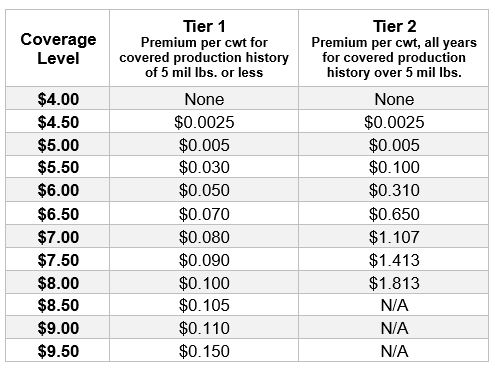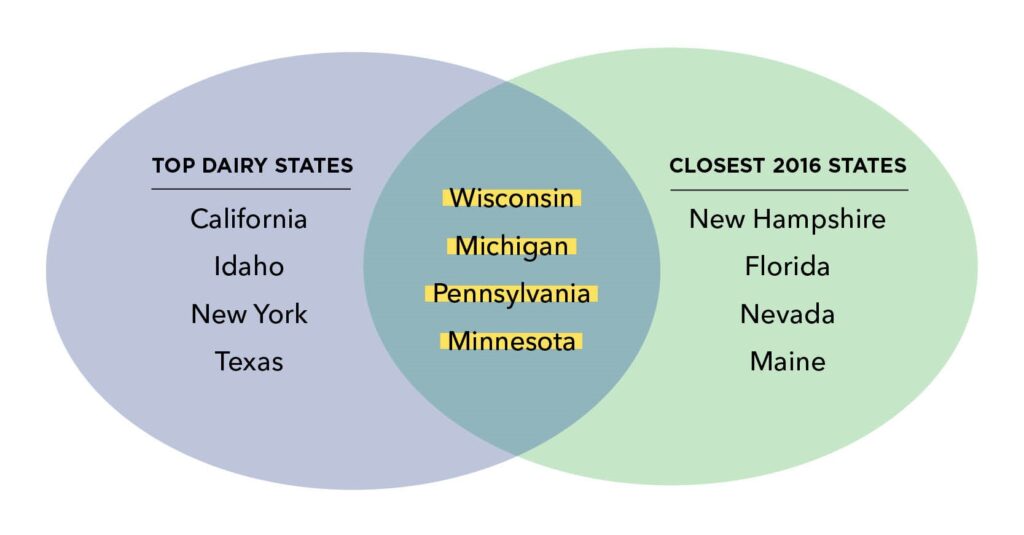With the ongoing COVID-19 crisis teaching hard lessons on risk management throughout agriculture, and with dairy margins expected to be volatile over the next year, the National Milk Producers Federation (NMPF) urges farmers to sign up for maximum coverage in 2021 under the Dairy Margin Coverage (DMC) program.
DMC is designed to ensure that dairy farmers can protect themselves against financial catastrophe. Despite forecasts in late 2019 predicting that DMC was unlikely to generate payments in 2020, margins fell to their lowest levels in more than a decade in the first half of this year, triggering payments that kept many dairies afloat. The current USDA forecast indicates margins will drop below $9.50/cwt. in the first half of 2021. DMC coverage offers certainty in times of need, allowing for better financial planning and faster payment when necessary.
Enrollment for the 2021 DMC program year starts today and runs through Dec. 11. See below and visit USDA’s Farm Service Agency’s DMC page for more information.
ELIGIBILITY
All U.S. dairy operations are eligible for DMC. An operation can be run either by a single producer or multiple producers who commercially produce and market milk. Each producer on an operation must share the risk of producing milk and make contributions (including land, labor, management, equipment, or capital) to the dairy’s operation at least equal to the individual or entity’s share of the operation’s proceeds.
An eligible dairy operation must:
- Have a production history determined by USDA’s Farm Service Agency (FSA).
- Be registered to participate during a signup announced by FSA.
- Pay a $100 administrative fee annually for each year of participation, except if the dairy operation qualifies for a waiver for limited resource, beginning, socially disadvantaged, or veteran farmers and ranchers.
A dairy operated by more than one producer still will be registered as a single operation. Producers who operate two or more dairies need to register each operation separately to cover that operation.
Eligible DMC participants are also eligible to participate in the Livestock Gross Margin for Dairy Producers Program and the Dairy Revenue Protection Program. Both are administered by the USDA Risk Management Agency.
COVERAGE LEVELS
Producers have multiple options for coverage each year. Basic catastrophic coverage of $4/cwt. is free, except for the $100 annual administrative fee. Farms can insure their first 5 million pounds of milk production history, designated as Tier I, in 50-cent increments from $4/cwt. up to $9.50/cwt. Annual production above 5 million pounds falls into Tier II. Coverage options in Tier II range from $4/cwt. to $8/cwt. Producers must also select a coverage percentage of the dairy operation’s production history ranging from 5 percent to 95 percent, in 5-percent increments.
The following table provides the premium schedule.

HOW TO APPLY
FSA opens enrollment for DMC on Oct. 13 for calendar year 2021. The deadline to enroll for 2021 coverage is Dec. 11.
All dairy farmers who want 2021 coverage must visit their local USDA Service Center office to pay the annual administrative fee, which is $100 for all coverage levels. Producers must visit their local office even if they locked in coverage in 2019 for five years to take advantage of the 25% premium discount offered the first year of the program.
ADDITIONAL SUPPORT
USDA offers a variety of programs that have helped dairy farmers in addition to DMC, including insurance, disaster assistance, and conservation programs. Most recently, the first round of aid under the Coronavirus Food Assistance Program provided $1.75 billion in direct relief to dairy producers who faced price declines and additional marketing costs due to COVID-19 in early 2020. Signup is now underway for a second round of CFAP payments, offering further assistance for dairy producers and many other eligible producers. CFAP 2 applications are being accepted by FSA offices now through Dec. 11.
ADDITIONAL RESOURCES
For more information, visit the farmers.gov DMC webpage, or contact your local USDA Service Center. To locate your local FSA office, visit farmers.gov/service-center-locator.








